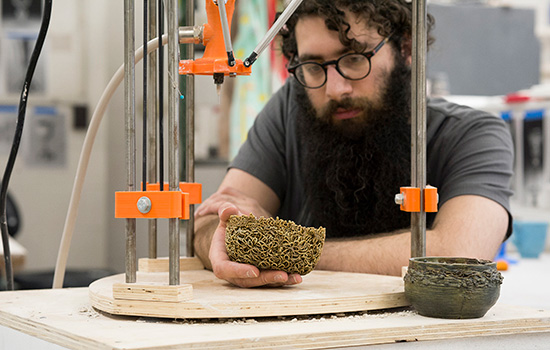3D ceramic printing on the rise
A. Sue Weisler
Dan Gabber, a master's ceramics student from Summit, N.J., believes this 3D ceramic printer built by RIT students will enable more freedom to create.
Last February, the ceramics program in RIT’s School for American Crafts hosted Bryan Czibesz for a three-day workshop during which students and College of Imaging Arts and Sciences faculty worked with the visiting artist to create a 3D printer from scratch.
“3D ceramic printing is a hot thing in a number of creative disciplines,” said Peter Pincus, visiting assistant professor in SAC. “As it is becoming an artist’s expressive tool, that’s when I think it becomes more interesting.”
Like most 3D printers, the ceramic printer operating inside SAC—the college’s first-ever installation of one—uses computer-aided design (CAD) files. After the machine is programmed, wet clay is pumped through the instrument in concentric loops on the way to becoming an artist’s creation.
Guided by Czibesz, RIT students built the printer through open source material on the internet.
“It’s relatively new technology and our goal is to bring it into the curriculum because it’s a wonderful experience for our students to engage in,” said Jane Shellenbarger, associate professor. “Like any digital technology, it has wonderful possibilities. We’re trying to make it accessible to our students and see how they respond.”
One of those students is Dan Gabber, a ceramics graduate student from Summit, N.J. “I have always been very interested in process-heavy design work and I think that is why I fell in love with ceramics,” said Gabber, who earned his undergraduate degree in RIT’s industrial design program.
“The crafts are full of innovators and people exploring the limits of materials and ideas,” he added. “I think that 3D printing in clay is further proof of that.”
As he becomes more familiar with the ceramic printer’s variables and capabilities, Gabber is discovering that it “provides access to unique shapes and textures that are either very time consuming or otherwise impossible.”
“As we understand the clay printer more as a tool to create art it allows us a huge amount of freedom,” he said.
While 3D ceramic printing is still in its relative infancy, according to Shellenbarger, “it’s yet another tool that enables makers to expand the breadth of their work.”
Gabber credited both Pincus and Shellenbarger for “having a rich understanding of clay and understanding the importance of technology in relationship with the crafts.
“The environment here at RIT, where crafts and technology meet, is the only place that I could have imagined myself,” he said.















